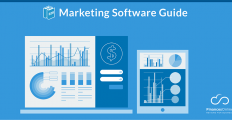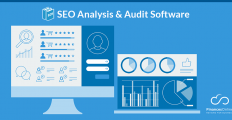Data is considered by many to be the world’s most valuable commodity. Experts deem it the oil of the digital era. Fortunately, for companies, their very own data is free. Useful information, however, isn’t. Organizations must perform work to turn data into useful information that they can use to generate actionable insights. This is where business intelligence software tools come in. It is good to note though that the quality of useful information that you can extract from raw data also depends on the quality of your tools. Two of the best business intelligence tools out there are Sisense and Power BI. And, they always end up on the shortlists of software hunters like you.
As we are dedicated to helping you to find the right software programs that fit your needs, a Sisense vs Power BI comparison is, thus, in order. In this article, we will compare these two products and their core features. We will also discuss each product’s strong points and weak points. Furthermore, use cases will also be included. In this way, you will have an idea of which tool would fit your needs best.

Sisense vs. Microsoft Power BI Comparison Table of Contents
In fast-paced and dynamic markets, only BI solutions will make you aware of otherwise undetected market patterns. This entails data visibility, data storytelling, and predictive modeling. Business intelligence tools provide users with these abilities and more. Thus, these became one of the most sought ought software products in recent years.
In COVID-stricken 2020, it has become really popular in air travel services around the world. A survey indicated that 87% of airports wanted to adopt BI solutions for functions such as cybersecurity (94%), cloud services (90%), and in-house remote and mobile services (84%). Other industries that are not typically associated with BI use are also vocal about the impact of BI on their operations. In 2021, 22% of law firms revealed that BI has a major impact on their business while a good 43% claimed it had a moderate impact.
Ease-of-Use of BI Platforms: Lowering Barriers to Adoption
share of users requiring online help to operate software products
Source: CSA Research, 2021
Designed byAlso, the surge in BI adoption can be attributed to the new level of ease of use provided by modern tools. A survey showed that only about 32% of respondents required online help in using BI software in 2021. This is quite low compared to other software categories like productivity (63%), software development tools (57%), and email and messaging apps (41%).
Lastly, as the tight competition among providers lowered software price points, a traditional barrier to adoption has also been lowered. In 2021, researchers found that more than half of businesses, at 54.40%, already use BI software tools. We expect this percentage to increase in the coming years. So, it is high time for firms to ramp up their business intelligence programs and adopt the necessary software tools to execute them.
Overview
Sisense

Sisense is a powerful BI software for any industry. It is highly customizable to an organization’s needs and can be deployed in a wide variety of settings, from startups to large enterprises. In fact, Sisense is a favorite among many iconic organizations such as NASA, ESPN, and Sony. This is because you can infuse analytics everywhere—from workstreams, hardware, and third-party products.
Thus, it provides users with a 360-degree view of their data across different siloes. These include integrations between cloud and on-premise data sources and platforms such as AWS, Google, and Microsoft.
Key features include pre-built analytics tools such as predictive analytics powered by state-of-the-art machine learning. Moreover, it allows both code and no-code exploration of data. Hence, it has high out-of-the-box usability for non-tech users.
Detailed Sisense Review
Power BI

Microsoft Power BI is an interactive data visualization solution designed primarily for business intelligence. Like Sisense, it is a suite of apps, connectors, and software services that help users gather, integrate, and make sense of once-disparate data sources. Then, it provides the tools to generate easy-to-understand visualizations to help them develop actionable insights. Moreover, the platform also allows users to create their own metrics and dashboards on top of built-in analytics packages.
Key features include modules for the management of datasets, ad-hoc reporting, and ad-hoc analysis. Also, it provides users with a great set of trend indicators and an easy-to-use interactive reports authoring interface.
Also, the product has a robust no-code to low-code functionality. Hence, quants with lesser to no coding backgrounds can still make use of the platform.
Detailed Microsoft Power BI Review
Comparison of Sisense vs. Power BI
Core Features
Customizable Smart Data Visualizations
Both Sisense and Power BI have superb data visualization capabilities. Moreover, they also provide an easy-to-use drag-and-drop interface to design them. Thus, users will be able to optimize the way how their information will be displayed quickly. Furthermore, these tools provide users with the opportunity to compartmentalize data, perform drill down, and create hierarchies.
While Sisense and Power BI allow users to create visualizations from scratch, they also provide common built-in presets to expedite the reporting processes. These presets are tried and tested data curation assets that are being used in a wide range of industries. Visualizations include scatter charts, bar charts, and even maps, among many others. Furthermore, both products allow these visualizations to be presented in an app-like format. In this way, they will become more intuitive for non-analysts.

Sisense’s user interface supports drag-and-drop functions for easier creation of visualizations.
Data Integration
Data integration is a very important feature in business intelligence platforms. This allows users to connect various data sources to identify more correlations and patterns to generate actionable insights. Before, analysts would extract data from different platforms and data warehouses and upload them to a BI software product. Today, however, this is made easier using data connectors and integration. Also, this allows for up-to-minute and even real-time updates and sync.
Both Sisense and Power BI have great real-time data integration capabilities. Power BI provides more than 500 built-in data connectors for third-party platform integrations. With this, users can achieve a real-time analytics stream from factory sensors to social media sources.
On the other hand, Sisense offers its propriety API so users can connect it with virtually any application. It has a Sisense Fusion Embed feature that can infuse analytics experiences into all applications and workflows. Also, Sisense provides Hybrid data handling capabilities. This means users can add a chasing layer of data on top of a data warehouse selected. In this way, they can use additional sources of information in their data model without disturbing the selected warehouse.
Mobile Experience
Having your BI platform available on the go can be very rewarding. This does not only allow you to monitor key performance areas in your company but also allows you to make quick data-driven decisions on the go. Moreover, this also increases the shareability of information and is very useful in impromptu sales pitches and emergency meetings. Thus, top business intelligence tools provide their clients with native mobile applications. This is true for both Power BI and Sisense. Both products have mobile versions for both Android and iOS devices. Also, both provide intuitive analytics experiences. If you compare Sisense vs Power BI in terms of mobile ease-of-use, they are more or less on par with each other.
Tailored/Adaptive Analytics
Great analytics platforms should be flexible enough to be deployed for any type of operation. After you compare Sisense and Power BI, you see these are flexible tools. In fact, they are being used by many companies across different industries. Sisense is the go-to BI platform for organizations like Nasdaq, Skullcandy, and NASA. Companies such as T-Mobile, Toyota, and P&G have Power BI as their business intelligence solution of choice.
Both products really offer users a blank canvas where they can create analytics tools for themselves. These include their very own metrics and custom data models. Ultimately, the usefulness and capability of these platforms really depend on the creativity and resourcefulness of their users. Also, they can be tailored to fit different desired outcomes. These range from general reports for C-suite executives to highly-technical real-time dashboards for big data scientists. In this Sisense vs Power BI point of comparison, there is really not much difference in terms of the quality and ease of execution.
Lends to Governed Deployment
Both Sisense and Power BI offer great self-service and governed deployment capabilities. Users get access to IT-governed data warehouses while they are also afforded the ability to perform analytics on their own. This democratizes analytics while also keeping data safe. This is thanks to features like connectors and an API that allow the platform to pull from different data sources in real-time combined with individualized self-service features like dashboards, drill-downs, visualizations, and reporting. Users are able to conduct analysis using shared data pools without corrupting the source data.

Power BI allows users to pool data from various governed warehouses for analysis without tampering with the original.
Historical Data Trends Analysis
Historical data trends analysis is important in many ways to businesses. Firstly, it allows them to identify pain points and behavioral patterns contributing to inefficiencies. Secondly, historical data trends also help businesses create projections that are useful in scenario planning. Thus, it is imperative for business intelligence platforms to include historical data trends analysis as features. As this is a given feature for all BI apps, both Sisense and Power BI have this. Also, both products have virtually identical historical data trends analysis features.
Both allow users to explore historical data through visualizations. Users can click on different data points to drill down and analyze fluctuations and other irregularities. Moreover, both products are AI-driven. Thus, they provide AI-generated insights to help users quickly identify patterns and come up with interpretations and, ultimately, action plans.
Pre-Built Analytics Templates
No BI platform is complete without pre-build analytics templates. Both Sisense and Power BI provide users with quick templates, including visualizations that can be customized as well. Power BI has pre-built dashboards such as those for tracking well-being, sales effectiveness, business continuity, and ways of working assessment. Sisense, on the other hand, is known for built-in industry-specific dashboards for IT, Software, Healthcare, Retail, and Customer Service. Both products offer a huge range of customization options. Thus, you can really make these dashboards your own.

Power BI shows data visualizations right on your dashboard.
Security
Sisense and Power BI are both trusted for the level of security that they provide to their clients. The Power BI service is built on Microsoft Azure, which is one of the safest cloud computing infrastructures available today. It is hailed not only for its stellar data storage security but also for its robust user authentication processes. Sisense, on the other hand, has certifications from ISO, HIPAA, GDPR, and SOC 2 Type 2. Thus, users can rest assured that their company data, personal data, and their BI platforms are safe, private, and secure.
Moreover, both products also offer role-based access controls. These enable administrators to allow or deny individuals access to any information or digital asset within the system.
Sisense vs. Power BI Core Features Takeaways:
- Sisense and Power BI provide users with customizable interactive smart data visualization features. So, both programs can help in creating useful data models and highly-visual engaging reports.
- Both products integrate with other platforms and data sources. Sisense and Power BI can integrate both on-premise and cloud data warehouses and platforms to create a single hub for anything analytics.
- Native mobile applications for both suites are available for Android and Apple devices.
- Both BI suites provide users with the ability to tailor analytics and reporting experiences to different audiences, from general management reports to highly-technical drill-down dashboards for specialists.
- Sisense and Power BI offer governed data deployment yet provide individual users tools for self-service analytics using synced data. Furthermore, they also ensure that shared data sources are not corrupted even when heavy manipulation has been done on the BI platform’s end.
- As all BI solutions go, both Power BI and Sisense have historical trends analysis features. These allow users to isolate useful patterns and analyze anomalies and fluctuations to explore possible causes.
- The two solutions offer a wide range of pre-built analytics templates and visualizations. Some are business-process-specific while others are industry-specific. All, however, can be customized.
- Both Power BI and Sisense are highly secure platforms when it comes to data and user information. Moreover, the two of them provide users with comprehensive role-based permissions as well.
Integrations

Sisense also offers data connectors to many third-party platforms.
Business intelligence solutions have to seamlessly integrate with third-party cloud and on-premise applications in order to gather real-time data from them. On this front, both products here have a wide range of integration options. They allow businesses to connect virtually all tech assets, from factory sensors and vehicle GPS to social media feeds and financial software products.
Power BI, as a Microsoft product, integrates seamlessly with Excel and has great interoperability quality. Hence, this can be a great fit for organizations that heavily rely on Excel for analysis and reporting that are entertaining dedicated BI software adoption. So, when it comes to Sisense vs Power BI for these companies, Power BI takes the upper hand.
On the other hand, Sisense can virtually work with any third-party application because of its API. This can also be achieved with Power BI but Sisense is more straightforward and intuitive in this regard. Plus, Sisense actively helps users set this up as well. Thanks to its Sisense Fusion Embed, users are able to use analytics within all facets of your digital architecture. By having analytics in different workflows and products, companies can easily quantify performance and be able to make data-based predictions from all organizational vantage points. Thus, when it comes to advanced embedded analytics, our Sisense vs Power BI comparison verdict goes to Sisense.
Sisense vs. Power BI Integrations Takeaways:
- Both products are great in terms of creating and fostering an analytics culture for companies. However, Sisense has more advanced capabilities, especially with its Sisense Fusion Embed feature that allows users to embed analytics in every facet of their digital architecture.
- Power BI seems to be better for organizations that are looking to move to a dedicated BI platform directly from Excel. As a Microsoft product, Power BI has great interoperability with Excel and other legacy Microsoft tools.
Pricing
Sisense vs Power BI pricing are done differently. Sisense, as a more nuanced BI solution, is only available via quotes. This is because its deployment is tailored according to a business’s needs. And, subscribers only get and pay for the modules and features that they need. Power BI, on the other hand, has tiered pricing packages. It has a general business-use deployment. So, users will be able to pick and choose which plan, to some degree, would fit their needs best according to the available features.
Considering their pricing schemes, we suggest that Power BI is best for smaller operations for general business use. It is more scalable in the sense that you can start small and grow your subscription as your needs grow. On the other hand, Sisense, with all its advanced features, is a better fit for enterprise-level business intelligence. You don’t need a bazooka for deer hunting.

Power BI offers tiered pricing packages.
Sisense vs. Power BI Pricing Takeaways:
- Power BI offers scalable tiered plans and is best for smaller operations.
- Sisense is deployed according to an organization’s needs. Thus, it is only offered via custom quotes. Moreover, with its advanced features, it is a better fit for larger companies.
Ease of Use

The Sisense interface has an easy-to-use drag-and-drop functionality.
When it comes to ease of use, both products really score high. However, as most things go, this is quite relative. For companies with experienced and dedicated analysts and data scientists, Sisense would likely be the program of choice when it comes to ease of use. Firstly, as a dedicated BI platform, its interface does not feel tethered to a greater suite like Power BI is. For companies that are heavy Microsoft users, then Power BI is a logical extension. It is good to note, however, that both products come with high out-of-the-box usability. A true Sisense vs Power BI comparison here, however, is not really possible because of the reasons mentioned. But, it is worth mentioning that both sport drag-and-drop functionality and are very intuitive within their frameworks.
Sisense vs. Power BI Ease of Use Takeaways:
- Power BI is part of the overall Microsoft suite. Thus, it retains the overall look and feel of the legacy applications. For many, especially those that are Microsoft users, this is a big plus as they won’t need to adapt to a totally different interface look and feel.
- Sisense, on the other hand, is a standalone BI solution. Thus, it has an originally-designed interface that is also very intuitive to use. Like Power BI, it has easy drag-and-drop functionality and you can easily access all of its features through its main dashboard in just a few clicks.
Getting Started
Both products have hybrid deployment in the sense that both have on-premise and cloud versions. Out-of-the-box usability, as mentioned, is quite high. This, however, depends on the scale that you need your BI and analytics to be. So, if you require big data capabilities, then it will take a longer time to set up your platform than if you want a simple self-service BI for an SME. It is also worth noting that for SMEs, Power BI would seem to be a better fit. For larger corporations, especially future-forward firms that plan to leverage 5G tech, then Sisense would seem to be the better choice. This is also because custom development and on-premise setups are also being offered by the company. This is especially useful when in-house setup takes up too many resources and self-service is not really enough.
Sisense vs. Power BI Getting Setup Takeaways:
- For smaller operations, Power BI is way easier to get started using because of its scalable tiered packages. Like Sisense, it has both cloud and on-premise setups. But, you can easily sign up and start right away.
- Sisense, on the other hand, is designed for more advanced BI and analytics that large organizations need. Thus, it takes more time to set up, especially when physical on-premise configurations are required. Also, it takes a bit more time to sign up and start as it is customized according to your requirements.
Use Cases
As members of a general product category, both have similar use cases. Moreover, both are very pliable and would be made to fit whatever analytics purpose you may have in mind. As mentioned, both products are being used in many different companies across industries. At the level of a particular firm, both Power BI and Sisense can be deployed for BI uses in different business processes.
Of course, these include comparing sales performance and marketing communications activities. One can also perform sensitivity analysis in promotions. These products can also be deployed in sports management settings. Even though the difference between Sisense and Power BI, in terms of user cases, is quite minute, Sisense seems to be more advanced in terms of features and capabilities. This is by virtue of being a standalone BI suite. Thus, for more complex setups involving embedding analytics in factory machines and other workflows, Sisense just has an edge over Power BI, thanks to its native Sisense Fusion Embed technology. For general BI processes in business, Power BI is more than enough for many large enterprises.
Sisense vs. Power BI Use Cases Takeaways:
- Sisense and Power BI are both flexible BI platforms that organizations can use in a wide variety of settings, from employee wellness to application usage.
- For more complex big data and business intelligence purposes that require embedded analytics, Sisense may be a better candidate than Power BI.
Sisense vs. Power BI Comparison Table
| Sisense | Power BI | |
| Ideal for |
|
|
| Use cases |
|
|
| Core Features | ||
| Customizable Smart Data Visualizations | ✓ | ✓ |
| Data Integration | ✓ | ✓ |
| Mobile Experience | ✓ | ✓ |
| Tailored/Adaptive Analytics | ✓ | ✓ |
| Lends to Governed Deployment | ✓ | ✓ |
| Historical Data Trends Analysis | ✓ | ✓ |
| Pre-Built Analytics Template | ✓ | ✓ |
| Security | ✓ | ✓ |
| Key Integrations | ||
| Microsoft Azure | ✓ | ✓ |
| Google BigQuery | ✓ | ✓ |
| MySQL | ✓ | ✓ |
| Amazon Web Services | ✓ | ✓ |
| Pricing | ||
| Starts from | By Quote | $99.9 per user/month |
| No. of plans |
Custom Plans |
3 |
Business Intelligence for Competitive Edge
According to recent business intelligence statistics, the combined market size of the analytics and BI markets reached $15.94 billion worldwide in 2021. By 2024, experts predict that it will reach $17.6 billion. This optimism seems to be rooted in the fact business intelligence software adoption is getting more popular. And, as discussed before, this is happening for at least two reasons. Firstly, firms are more aware now of the competitive advantage that business intelligence can bring. Secondly, the barrier to adopting these products is continuously being lowered over the past decade.
In fact, more and more business solutions now offer powerful analytics modules embedded within their products. If you take a look at the top project management solutions, each of them provides customizable reporting tools to track progress and KPIs in real-time. The same goes for popular CRM and marketing software suites among many others. This just shows that organizational culture nowadays is rapidly undergoing a comprehensive shift from gut-feel and eye-test decision making to data-driven strategizing.
This is not just a fad. It is one of the many strong business intelligence trends. Innovators, early adopters, and the early majority can attest to the positive impact of a data-driven culture. Also, by having a head start, many of them have established huge competitive advantages. If you haven’t started yet, you can never be too late. Business intelligence and analytics is a fast-developing field and is bound for more disruptions and innovations in the future. If you missed the first wave, then there are more to come.
Sisense vs. Power BI? Which one is better?
The answer ultimately depends on what you need a BI platform for and where your company is in terms of growth. Both are robust yet flexible platforms that provide self-service analytics tools over a governed data architecture. This means that these programs can provide you with simple intuitive tools to create data models based on real-time verified data from your data warehouses and other trusted sources. Moreover, both of them have pre-built analytics tools with great visualizations that can make sense of raw complex data into useful actionable information. However, both are stronger than the other in two different niches.
For large corporations looking to embed analytics experience into every workflow and digital platform, we would recommend Sisense. It has a great propriety technology that can help you create your very own IoT network for real-time data streams. Moreover, it is fitted with more features for advanced custom analytics with robust big data analytics capabilities. Hence, it is a great fit for more complex operations, especially in cutting-edge technology and innovation. In fact, it is the go-to BI platform for NASA. That says a lot.
On the other hand, for self-service analytics for everyday business, you can never go wrong with Power BI. This is especially true if you are already using Microsoft products. It has great Excel interoperability and is perfect for firms or even individuals who want to jump in right away with no hassle. This, of course, is not to say that it is not capable of heavy computation and complex analytics. Power BI is the go-to solution for many established brands like HP, Heathrow, Arla, and Nestle.
So, the choice is up to you. You can still augment your options with these top alternatives to Power Bi, too.
Key Insights
- Importance of Business Intelligence: Business intelligence (BI) tools like Sisense and Power BI are crucial for transforming raw data into actionable insights, aiding organizations in decision-making and strategic planning.
- Adoption Rates: The adoption of BI software is growing, with more than 54% of businesses using BI tools as of 2021. The adoption rate is expected to rise as the barriers to entry, such as cost and ease of use, continue to decrease.
- Ease of Use: Modern BI tools are designed to be user-friendly. Only 32% of users required online help to operate BI software in 2021, which is lower than other software categories like productivity tools and email apps.
- Versatility and Customization: Both Sisense and Power BI offer customizable data visualizations, real-time data integration, and mobile access, making them suitable for a wide range of industries and business sizes.
- Integration Capabilities: Sisense provides advanced integration with its API and Sisense Fusion Embed, allowing analytics to be infused into various workflows. Power BI, being a Microsoft product, integrates seamlessly with Excel and other Microsoft tools.
- Pricing Models: Power BI offers scalable tiered pricing, making it suitable for smaller operations. Sisense, available via custom quotes, is tailored for larger enterprises with more complex needs.
- Security: Both Sisense and Power BI offer robust security features, including role-based access controls and compliance with various security standards like ISO, HIPAA, and GDPR.
- Mobile Experience: Both platforms have native mobile applications for Android and iOS, enabling users to access and interact with their data on the go.
FAQ
- What are the primary benefits of using business intelligence software like Sisense and Power BI?
Business intelligence software helps organizations transform raw data into actionable insights, improving decision-making and strategic planning. These tools offer features like customizable data visualizations, real-time data integration, and mobile access, enhancing overall business efficiency and performance. - How do Sisense and Power BI differ in terms of ease of use?
Both Sisense and Power BI are user-friendly, with intuitive drag-and-drop interfaces. Power BI is particularly easy to use for organizations already familiar with Microsoft products, while Sisense offers a more standalone interface suitable for experienced analysts and data scientists. - What integration capabilities do Sisense and Power BI offer?
Sisense provides advanced integration through its API and Sisense Fusion Embed, allowing analytics to be embedded into various workflows and applications. Power BI integrates seamlessly with Excel and other Microsoft tools, making it ideal for organizations transitioning from Excel to a dedicated BI platform. - Which platform is better for smaller operations or startups?
Power BI is generally more suitable for smaller operations and startups due to its scalable tiered pricing and ease of integration with existing Microsoft products. Its affordability and flexibility make it an excellent choice for businesses looking to start small and grow their BI capabilities over time. - Which platform is recommended for large enterprises with complex BI needs?
Sisense is better suited for large enterprises with complex BI needs, particularly those requiring embedded analytics and advanced custom analytics capabilities. Its flexibility and powerful features make it ideal for organizations looking to leverage big data and cutting-edge technology. - What security features do Sisense and Power BI provide?
Both Sisense and Power BI offer robust security features, including role-based access controls and compliance with various security standards such as ISO, HIPAA, and GDPR. These features ensure that company data and user information are kept safe and secure. - Can I use Sisense and Power BI on mobile devices?
Yes, both Sisense and Power BI have native mobile applications for Android and iOS, allowing users to access and interact with their data on the go. This mobile access enhances flexibility and ensures that important data is always within reach. - How do Sisense and Power BI support data integration?
Sisense offers advanced data integration capabilities through its API and Sisense Fusion Embed, allowing it to connect with virtually any application. Power BI provides over 500 built-in data connectors for third-party platform integrations, enabling real-time analytics streams from various data sources. - What pricing models do Sisense and Power BI use?
Power BI offers tiered pricing packages, starting at $99.9 per user per month, making it more accessible for smaller businesses. Sisense, on the other hand, is available via custom quotes and is tailored to an organization’s specific needs, making it more suitable for larger enterprises. - What pre-built analytics templates do Sisense and Power BI offer?
Both Sisense and Power BI provide pre-built analytics templates and visualizations. Power BI includes templates for tracking well-being, sales effectiveness, and business continuity, while Sisense offers industry-specific dashboards for IT, software, healthcare, retail, and customer service. Both platforms allow for extensive customization of these templates.

























Leave a comment!